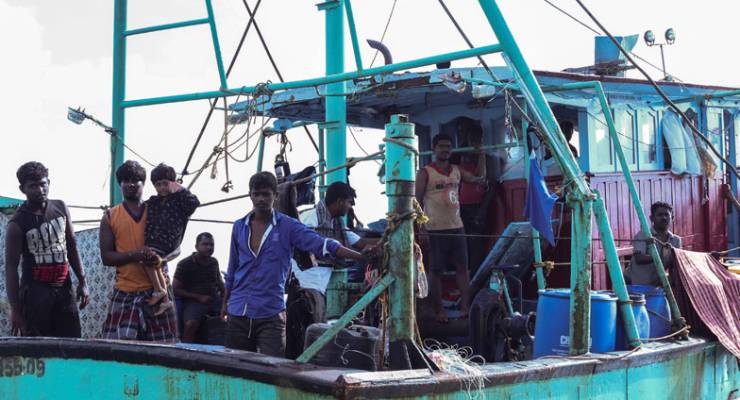
On June 18, independent MP Andrew Wilkie introduced the Refugee Protection Bill with an intention of both returning human rights principles to Australian immigration law and establishing a network of asylum application centres throughout the Asia-Pacific.
While seconded by independent MP Cathy McGowan, the bill has developed little political traction, and recent medical alarms on Nauru have instead ramped up pressure to evacuate children and families.
But while Australia’s immediate focus should obviously be on saving detainees suffering historic mental trauma rates, could Wilkie’s bill — at least on paper — offer a more sustainable, long-term framework?
What would the bill do?
The bill would enable the Asia-Pacific Asylum Seeker Solution (APASS), a regional network of centres where people seeking asylum could be registered, have immediate humanitarian and legal needs met, and lodge three preferences for countries of resettlement.
Wilkie has argued that, in order to create regional support, Australia would need to display responsibility on intake, cost sharing, and dialogue through regional forums such as the Bali Process or ASEAN.
“What these centres look like and how they operate can only be determined by parties to APASS but they must be developed in accordance with international refugee and human rights law,” Wilkie told Crikey. “A good model here in Australia is the Asylum Seeker Resource Centre, which provides legal advice, links to services, support, food, clothing and accommodation.”
In re-implementing UNHCR guidelines, the Refugee Convention and other human rights laws, the bill would also ban mandatory detention and turnbacks.
What are the logistical challenges?
First, the plan would require international co-operation, and while Indonesia, the most obvious candidate for APASS, has recently called on Australia to increase its regional intake of refugees, there has been no obvious interest in building new processing centres.
Any plans would be compounded by both the toll Australia’s deterrence system has had on relations with Indonesia and the legal challenges of processing refugees in countries that are not signatories to the Refugee Convention.
Secondly, as the bill’s explanatory memorandum makes clear, the legislation would only establish a mechanism for the bilateral centres, as it would be unconstitutional for a bill to direct the executive arm of government. Basically, cabinet would have to negotiate and implement APASS.
Finally, re-adopting the Refugee Convention’s ban on discriminating by methods of arrival would mean people could once again seek asylum in Australia by boat.
Wilkie argues that free, short stays at APASS centres would reduce the need for people smugglers, a claim supported by recent research trips to Indonesia. However, pointing to guidelines from the Australian Human Rights Commission (AHRC) and UNHCR for ensuring protection at sea, he also notes that, “it is important to acknowledge that people may still choose to arrive by boat and APASS countries, including Australia, would register such people at one of their APASS centres”.
Doesn’t Australia already do this?
Not anymore, although there is precedent for international co-operation under the controversial Comprehensive Plan of Action for Indochinese Refugees (1989-1997).
The UNHCR still processes refugees in Indonesia, however centres are overrun and require people to wait years to be assessed; the UN reported last year that most will never be resettled.
This is in part because in 2014 then-immigration minister Scott Morrison banned new refugees from applying in Indonesia for asylum in Australia, and slashed the caseload intake from 808 to 526, as a way of “taking sugar off the table”. According to Peter Dutton in August, there are “14,000 people in Indonesia waiting to get on to boats”.
Redirecting offshore detention funds to APASS would wildly overshadow UNHCR’s current operations.
“In 2014-15 Australia spent more than $1 billion on offshore detention where 1577 asylum seekers and refugees were detained,” Wilkie said. “This is more than five times the UNHCR budget, which was estimated to be $US157 million for 2015 that covered over 200,000 refugees, half a million internally displaced people and nearly 1.4 million stateless persons in the South East Asian region.”
What support does the bill have?
The plan has received official support from legal groups such as the Australian Lawyers Alliance, while Greens Senator Nick McKim has called the bill a “big step in the right direction” and said that “APASS centres appear similar to the Greens’ plan to establish a framework to assess people’s claims for protection in Indonesia and Malaysia.”
Opposition spokesperson on immigration Shayne Neumann only said the bill would be taken through Labor’s usual processes if brought on for debate, but also urged Morrison to take New Zealand’s offer to resettle Manus and Nauru refugees, and emphasised a 2016 Labor election commitment to increase Australia’s annual refugee intake from 17,555 to 27,000 by 2025.
Finally, as a lawyer at UNSW’s Kaldor Centre for International Refugee Law puts it, the logistical questions means “it’s not really possible to comment on whether the system proposed under the Refugee Protection Bill would work in practice”.
“But on a general note, the bill is important in that it proposes an alternative to the current regional processing models in Australia that don’t comply with international law.”
Immigration Minister David Coleman did not respond by deadline.
Do you think Wilkie’s bill is a good idea? Write to us at boss@crikey.com.au.








I really don’t understand why so much effort is put into proposing where and how to “process” asylum seekers.
The choke point is where they go after that, for the rest of their lives. Sure, they can nominate the country they’d like to go to – is that country then obliged to accept them, under this scheme? If not, I see more indefinite detention coming up…
It’s just lazy racism by Wilkie too, it’s quite legal to seek asylum by sea and forcing people to stay in danger in other countries has nothing to do with anything. Australia is so pathetic they make my hair hurt -EVERYONE HAS THE RIGHT TO SEEK ASYLUM FROM PERSECUTION, is not ambiguous yet we waste billions a year to prevent people from exercising that right and brain snap fools come up with all sorts of nonsense like this.
There would be no boats setting out from Indonesia were it not a lucrative industry for the routine corruption of every official the potential drowners (for whom the LNP are so selflessly concerned) encounter, from the visa free entry of all muslims on one way tickets at the airports, through to the local cops & spooks who have no idea that they are on a coastline which is well known to be inhabited by people with seafaring experience.
Not to mention the hotels & other accommodation whilst waiting to do whatever it is they’ve come to do.
It would help if there were less hypocrisy here from the usual suspects who persist in calling them all refugees seeking asylum when a sizeable portion are economic migrants who didn’t get 676 tourist or 457 work visas to overstay.